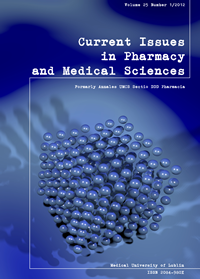The use of alloplastic biomaterials in the surgical treatment of aggressive periodontitis – a case report
DOI:
https://doi.org/10.12923/j.2084-980X/25.1/a.18Słowa kluczowe:
calcium sulfate, hydroxyapatite, bone regenerationAbstrakt
Periodontitis is a commonly encountered disease of the mouth, in man. This inflammatory process results in the impairment of the connective tissue attachment and alveolar bone resorption. Guided tissue regeneration, which aims at rebuilding the lost periodontal tissue and restoring its function, involves the use of barrier membranes and bone substitutes. This paper presents an aggressive periodontitis treatment with the use of a combination of alloplastic biomaterials applied in the anterior maxillary region of a 38-year-old female patient. The used biomaterials, i.e. hydroxyapatite and calcium sulfate, served as space fillers, the latter was also used as a barrier membrane. Satisfactory therapy results obtained in the patient were maintained throughout a 21-month postoperative follow-up period. Alloplastic materials appear to be useful in regeneration of the periodontal structures and may serve an alternative to xenografts and allogenic grafts.
Bibliografia
1. Anson D.: Calcium sulphate: A four year observation of the use as a resorbable barrier in guided tissue regeneration of periodontal defects. Compen Contin Educ Dent, 17, 895, 1996.
2. Brunsvold M.A. and Mellonig J.T.: Bone grafts and periodontal regeneration. Periodontology 2000, 1, 80, 1993
3. Jamali A et al.: Hydroxyapatite/calcium carbonate (HA/CC) vs. plaster of Paris: a histomorphometric and radiographic study in a rabbit tibial defect model. Calcif Tissue Int, 71, 172, 2002.
4. Mangano C. et al.: Maxillary sinus augmentation using an engineered porous hydroxyapatite: a clinical, histological, and transmission electron microscopy study in man. J Oral Implantol, 32, 122, 2006.
5. Maragos P. et al.: Comparison of three methods using calcium sulfate/barrier material for the treatment of class II mandibular molar furcation defects. Int J Periodontics Restorative Dent, 22, 493, 2002.
6. Mazor Z. et al.: Bone repair in periodontal defect using a composite of allograft and calcium sulfate (DentoGen) and a calcium sulfate barrier; J Oral Implantol, 37, 287, 2011.
7. Owczarek B., Kiernicka M. and Wysokińska-Miszczuk J.: Kompleksowe leczenie agresywnego zapalenia przyzębia z zastosowaniem metod zachowawczych i różnych technik chirurgicznych. Dent Med Prob, 39, 137, 2002.
8. Pecora G. et al.:, Bone regeneration with a calcium sulfate barrier. Oral Surg Oral Med Oral Patol Oral Radiol Endod, 84, 424, 1997.
9. Peltier L.F.: The use of plaster of Paris to fill defects in bone. Clin Orthop, 21, 1, 1961
10. Poulet P. et al.: Concentrations and in vivo antibacterial activity of spiramycin and metronidazole in patients with periodontitis treated with high-dose metronidazole and the spiramycin/metronidazole combination, J Antimicrob Chemother, 55, 347, 2005.
11. Quee T.C. et al.: The role of adjunctive Rodogyl therapy in the treatment of advanced periodontal disease. A longitudinal clinical and microbiologic study. J Periodontol, 58, 594, 1987.
12. Rotzetter P.A. et al.: Kinetics of spiramycin/metronidazole (Rodogyl) in human gingival crevicular fluid, saliva and blood. J Clin Periodontol, 21, 595, 1994.
13. Rosenblum S., Frenkel S., Ricci J. and Alexander H.: Diffusion of fibroblast growth factor from a plaster of Paris carrier. J Appl Biomater, 4, 67, 1993.
14. Sculean A., Nikolidakis D. and Schwarz F.: Regeneration of periodontal tissues: combinations of barrier membranes and grafting materials – biological foundation and preclinical evidence. A systematic review. J Clin Periodontol, 35, 106, 2008.
15. Silva R.V. et al.: The use of hydroxyapatite and autogenous cancellous bone grafts to repair bone defects in rats. Int J Oral Maxillofacial Surg, 34, 178, 2005.
16. Sottosanti J.: Calcium sulfate: A biodegradable and biocompatible barrier for GTR. Compend Contin Educ Dent, 13, 226, 1992.
17. Thomas M.V. and Puleo D.A.: Calcium sulfate: properties and clinical applications. J Biomed Mater Res Part B: J. Appl Biomater 88B, 597, 2009.
18. Trombelli L.: Which reconstructive procedures are effective for treating the periodontal intraosseous defect? Periodontology 2000, 37, 88, 2005.
19. Wolf H.F., Rateitschak E.M. and Rateitschak K.H.: Periodontologia, Wydawnictwo Czelej, Lublin; p. 192, 2006.
20. Yoshikawa G. et al.: Guided bone regeneration (GBR) using membranes and calcium sulphate after apicectomy: a comparative histomorphometrical study. Int Endod J, 35, 255, 2002.
21. Zaffe D. et al.: Behavior of aqueous nanocrystalline hydroxyapatite in oral bone regeneration. J Appl Biomater Biomech, 9, 19, 2011.
Pobrania
Opublikowane
Numer
Dział
Licencja
Prawa autorskie (c) 2012 Autorzy

Praca jest udostępniana na licencji Creative Commons Attribution-NonCommercial-NoDerivatives 3.0 Unported License.


